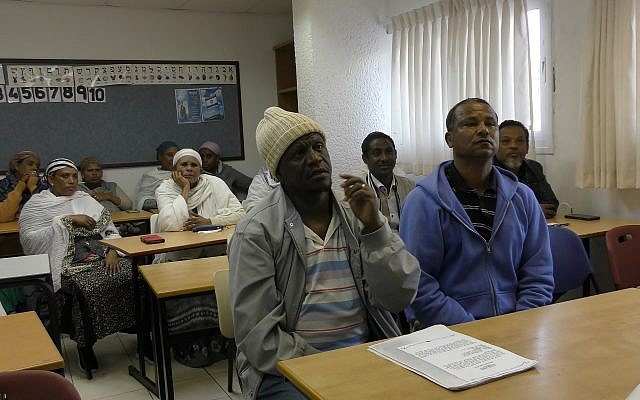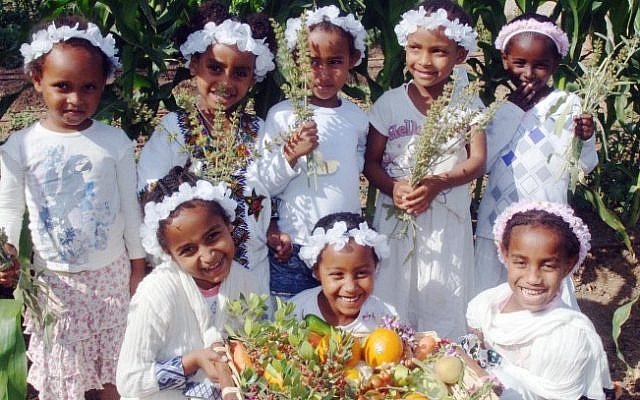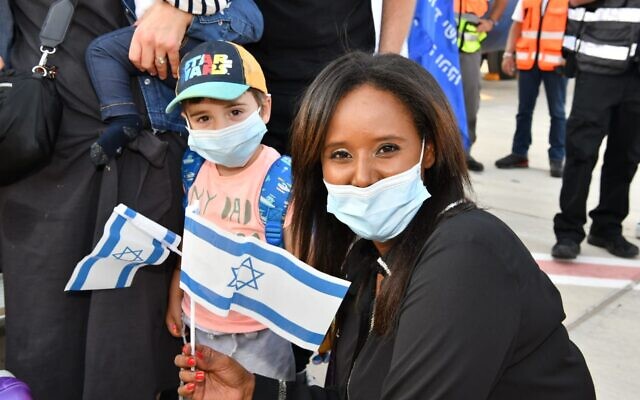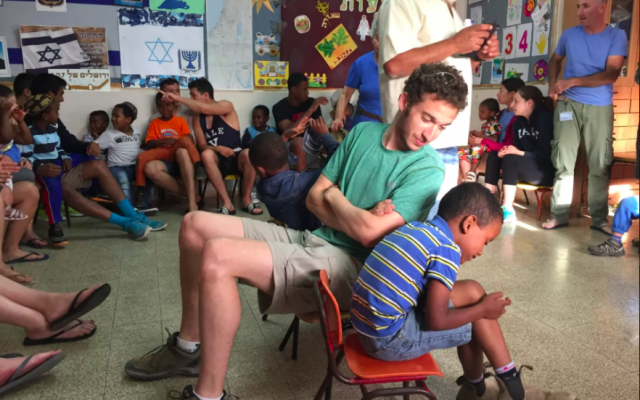Absorption Minister Pnina Tamano-Shata broke new ground with her appointment to the cabinet in May. She is the first Ethiopian cabinet minister in Israel’s history.
Breaking new ground does not mean old inequities are ended, of course. Tamano-Shata hails from a new elite in the community, one that has risen from a hardscrabble immigrant existence to break through entrenched glass ceilings across the spectrum of Israeli institutions and career paths, from academia to the military to politics and the corporate world. But most Ethiopian Jews in Israel still struggle with the aftershocks of their aliya and a poorly conceived absorption policy in the 1980s and 1990s. The Ethiopian Jewish community’s move to Israel traversed the largest economic and cultural gap of any immigrant group since the 1950s.
Tamano-Shata’s very success, from a childhood in an absorption center to a career as an activist, journalist and politician, has instilled an intense sense of responsibility for that community, a sense evident throughout her recent interview with The Times of Israel, which was carried out last month over Zoom. Israeli society, she clarified, wants to see its immigrant communities succeed, but needs a lot of help making it happen.
“I believe if we want to absorb well, the first obstacle is the language. The language. Someone wants to find work, find a home, and there are ulpanim [Hebrew-language study programs for new immigrants],” notes Tamano-Shata, “but it’s not enough.”

MK Pnina Tamano-Shata (left) with supporters of Avera Mengistu protest as they call for his release from Hamas captivity five years after he was kidnapped, in Tel Aviv on September 8, 2019. (Tomer Neuberg/Flash90)
“I love the Hebrew language. When I made aliya at age 3, one of my first memories was falling in love with the Hebrew language. Maybe it’s not such a coincidence that I later went on to study law and became a lawyer. And in general, in my past, not for quoting, I’m a singer who’s in love with Hebrew.”
“Why isn’t that for attribution?” she was asked.
Slightly embarrassed, Tamano-Shata answered: “Okay, you can write that, but it’s a side point.”
The main point: “I can tell you that many immigrants who went through the basic ulpan program say they still don’t know Hebrew and that it makes everything more difficult.”
We were among the first families from Ethiopia to arrive in Petah Tikva. We were an unusual part of the landscape. The difference in color was hard to miss.
Interviews with ministers follow a pattern: the journalist raises social or political problems, the minister agrees that the problems are serious and insists they’re committed to solving them. Then the conversation moves on to more piquant questions about the latest round of politicking.
Not so with Tamano-Shata. Nothing came up in the conversation for which she didn’t have specific policy solutions, budget sources and the names of officials and agencies that were already cooperating with her to implement the new program.
Tamano-Shata has a policymaker’s mind. She slogs bored and unhappy through political talking points, then turns animated and begins to speak more quickly when the conversation turns to policy. One soon finds that the only way to keep up is to interrupt with questions.

Classes in Judaism at the Hanita Absorption Center in Haifa. (Bernard Dichek/Times of Israel)
“So I wrote a program” to deal with the dearth of Hebrew education for immigrants, she begins. “and I’m moving ahead with the cooperation of the Association of Community Centers to open evening Hebrew lessons for everyone, even if you’re ten years in the country or 15 years. If you want to learn Hebrew, that has to be available, offered by the state, and not limited just to your first year or the first six months [in the country]. That’s very, very, very important.”
How do you pay for it?
The above exchange was characteristic of the whole interview.
She went on: “I’m going to embrace the immigrant lone soldiers more. The first year after their discharge is a shock, they’re alone here. I don’t want to see them leave the apartment they were given by the army [during their service period] and suddenly find themselves without any furniture and unable to rent an apartment. They don’t have all the basic things that parents would help with. I don’t come from the well-to-do layers of society. I had to make do from a very young age. I found myself after the army — even though my parents were there and were wonderful, they couldn’t help me — and I remember that anxiety of having to take a loan to rent an apartment with a friend. That was very hard. So we’re going to give an ‘acclimation grant’ each month to help them.”

Girls dressed in traditional white dresses hold a basket of fruits and vegetables as they stand in a field, ahead of the Jewish holiday of Shavuot. (Dudu Greenspan/Flash90)
There are at least half a dozen such programs, all prepared, mostly hammered out with the relevant agencies, and all expensive. How, The Times of Israel asked, did she plan to pay for them in the middle of an unprecedented economic slump and with the government facing a colossal budget deficit?
That’s just the thing, she noted, channeling the old adage that a crisis is a terrible thing to waste: billions of shekels are being spent on propping up an economy devastated by the pandemic. In some ways, if the cause is couched properly and negotiated well, there is more public money to be had at the moment for new programs and projects than at any time in the past 15 years.
When Prime Minister Benjamin Netanyahu promised to send all Israelis “stimulus” checks totaling some NIS 6 billion ($1.8 billion) — a move decried by some officials as a populist answer to the prime minister’s sagging poll numbers – the Blue and White party demanded that the spending favor the poor and newly unemployed. The 750-shekel ($223) one-time per-person grant given by the plan wasn’t nearly enough for someone who had lost their job, and was too little to be noticed by middle class or wealthy households. If the grants weren’t weighted toward those who needed them, went the argument, what was the point?

Lone soldiers get help dealing with government bureaucracy at an event sponsored by Nefesh B’Nefesh, Friends of the IDF and Israeli government ministries in 2015. (Courtesy Yonit Schiller/Nefesh B’Nefesh)
That demand sparked a brief but ferocious debate in government about who should be included in the favored groups whose grants would be higher. After Tamano-Shata entered the fray and raised the matter with her own Blue and White lawmakers as well as Likud ministers, including discussions with Finance Minister Israel Katz, new immigrants were included as one of the five favored groups who received larger checks than everyone else.
In the end, she says, “it was a debate about numbers. I showed them that immigrants in their first two years in the country face a 28 percent unemployment rate” — a figure from before the pandemic.
There was another problem, she discovered. New immigrants’ welfare grants did not come from the main national welfare agency, the National Insurance Institute, until they’d been in the country for a year. In a bid to streamline the bureaucracy for new arrivals, welfare benefits are delivered through the Absorption Ministry together with the regular immigration benefits. The upshot: since the government was using the NII to deliver the coronavirus grants, immigrants were skipped over. It took Tamano-Shata an intensive round of discussions with ministers and officials to ensure funds were directed correctly for new immigrants.

Brazilian immigrants to Israel in May 2020. (Olim do Brasil NGO via JTA)
It was a full court press. In all, 27 million previously unbudgeted shekels ($8 million) have gone to expanding financial aid to immigrants, NIS 42 million ($12.5 million) to new employment and job training programs, and NIS 11 million ($3.3 million) for vouchers for Hebrew studies — all drawn from the government’s various coronavirus rescue packages.
“I’m very proud of that,” she says. “My presence here is expressed in my ability to fight for the immigrants. That’s my service. I’m happy that that’s already borne some fruit.”
She’s right to be proud. It’s hard to exaggerate how central each minister’s role has become in drawing the newly available coronavirus funds to their ministry. Prime Minister Benjamin Netanyahu continues to refuse to legislate a state budget law, and refuses even to allow the Finance Ministry to prepare such a budget covering any period beyond the end of the year. That means that no central planning staff is coordinating and prioritizing all the pandemic-induced spending. Money is suddenly available in unprecedented amounts — the state’s roughly NIS 400 billion ($119 billion) annual budget is expected to swell to some NIS 550 billion ($163 billion) for 2020 due to the virus spending — but each minister must haggle and demand a share of the largesse for their particular fiefdom.

Absorption Minister Pnina Tamano-Shata welcomes new immigrants to Israel on August 3, 2020. (Shlomi Amsalem)
While the pandemic means more cash, it also brought a host of new problems for the ministry. There are no moments of grace in the virus-induced storm, at least not for a ministry dealing with the welfare of often impoverished immigrants.
The pandemic has meant a massive institutional shakeup for the ministry and its NIS 1.7 billion ($500 million) pre-pandemic annual budget. “I have 74 housing campuses with over 13,000 elderly living in them that are under the Absorption Ministry’s responsibility,” notes Tamano-Shata. “We have staff taking temperatures and checking in on everyone constantly. We’re running the quarantining of new immigrants who land in Israel. All those things are a major operation. The whole ministry has had to retool to provide services in a coronavirus[-safe] way.”
Anusim
The granddaughter of a kais, or Ethiopian Jewish rabbi, Tamano-Shata comes from a prominent Ethiopian Jewish family that traces its roots back to the legendary Abba Mahari, the famed Ethiopian Jewish spiritual leader whose failed 1862 attempt to reach the holy land is seen by Ethiopian Jews today as a prophetic harbinger of their move to Israel over a century later.
Her family came to Israel as part of Operation Moses in 1984, when she was three years old. But it arrived piecemeal.

New Ethiopian immigrants boarding an aircraft en route from Addis Ababa to Israel during Operation Solomon, 1991. (Natan Alpert/GPO)
“I remember immigration as a dramatic moment, but also a traumatic one. I was separated from my mother, who remained in the refugee camp. On the night of the transfer in trucks to the Israeli plane, the truck my mother was on with two of my sisters got stuck. The rest of my family, including myself at age 3, got to the plane, and only there we found out, when the doors had closed, that mother and my two sisters were left behind.
“I was incredibly lucky. She made it to Israel about a year later, a critical year for my family. The dream that came true, the dream of Zion, the dream of Jerusalem, the one that the Jews of Ethiopia prayed for for thousands of years, was a dream that also brought with it challenges of separation, of families torn apart. But I was very lucky; my family was reunited.”
She’s convinced to this day that “anyone who’s experienced immigration in their life, even at a very early age, that’s something that stays with you and shapes your identity throughout your life.”
Tamano-Shata lived in an absorption center till the age of seven before moving to an apartment in the central town of Petah Tikva.
“We were among the first families from Ethiopia to arrive in Petah Tikva. We were an unusual part of the landscape. The difference in color was hard to miss, and of course our language.”

MK Pnina Tamano-Shata attends a Knesset committee meeting on July 12, 2018. (Yonatan Sindel/Flash90)
She excelled at her studies, was part of a gifted program in her religious girls’ high school, went on to serve as an operations sergeant in the IDF Homefront Command, got her law degree and then, in 2018, when she was already an MK, a masters degree in public policy from Tel Aviv University, which she completed with distinction.
Her activism also began at an early age. As a teenager she founded clubs for at-risk youth. She was a student activist in college, campaigned against a much-criticized policy in the 2000s that saw Ethiopian blood donations destroyed over HIV fears, and led the public outcry when some religious schools refused to accept Ethiopian Jewish students.
She entered journalism in 2005, becoming one of the anchors of a Friday news broadcast on the public broadcaster then called Channel 1. She would go on to serve as the channel’s legal correspondent from 2008 until she joined the Yesh Atid party in 2012 and was elected to the 19th Knesset in 2013, becoming the first-ever Ethiopian Jewish woman to serve in the parliament.
She remained with Yesh Atid until March 29 of this year, when she joined the Benny Gantz-led half of the former Blue and White alliance that entered the unity coalition with Netanyahu’s Likud party, a jump that drew no small measure of public criticism.
That juxtaposition of a difficult start in life and her fast rise in Israeli journalism and politics informs much of her work. She came into the Absorption Ministry with a long list of solutions to problems others have scarcely noticed — and with certain convictions she says “keep me up at night.”

Illustrative: An absorption center in the northern Israeli city of Safed. (courtesy)
The Times of Israel asked about the remnants of Ethiopian Jewry that still remain in Ethiopia, the so-called Falash Mura who descend from Jews who converted to Christianity and have sought to return to Judaism and move to Israel in recent years. After the arrival of the “Beta Israel” Jews was completed in the 1990s, the government has been split over accepting into Israel a community claiming descent from Jews but which, unlike Tamano-Shata’s family and community, does not qualify for citizenship under the Law of Return.
Tamano-Shata rejects such qualms outright.
“There’s no question today that they’re anusim,” or Jews forced to convert in previous generations but who kept alive the knowledge that they were Jews. “Even for me, a scion to a long line of kaisim” – that is, someone rooted deep within the Beta Israel camp – “it’s clear that there’s a consensus among the kaisim and among everyone else that they need to be brought on aliya. They have returned to Judaism.”
And there’s a more basic issue at stake than their identity, she adds.
“Let’s be honest. Families were ripped apart” by the slow, piecemeal — some might say grudging — pace of immigration permitted to the Falash Mura by Israeli governments. “Immigration permits were handed down to slivers of families — two children here, the rest of the children there, parents who had to choose between children who came here and children who were left there. It’s not Jewish. We have to finish this issue. I live within my community. I see the suffering. And there’s no argument anymore within the community about whether they’re part of our community. We’re talking about just a handful of thousands, between 7,000 and 10,000. We can absorb them and close the [transit] camps [in Ethiopia].”

Members of the Falashmura community arrive at the Immigration offices at the Ben Gurion Airport on February 4, 2019. (Tomer Neuberg/Flash90)
“This is a human issue, an apolitical question. Everyone is served by a framework that expedites the immigration while closing the camps. I won’t accept dragging this out with 400 [immigrants a month]. Give me a fast pace, a year or two to finish the job, and we close the camps.”
Here, too, she already has a plan. She has held meetings with officials in the Prime Minister’s Office and Interior Ministry, spoken with the Ethiopian ambassador, and produced a draft cabinet decision that has already made the rounds of the relevant ministries. She presented her plan (Hebrew video link) in the Knesset on August 19. The plan estimates some 8,000 Falash Mura remain in Ethiopia and would see the immediate absorption of 4,500 of them in Israel by the end of the year, and bring the remaining 3,500 by 2022, shuttering the camps. The plan is slated to come up for a cabinet vote in the coming weeks.
Less than four months on the job, Tamano-Shata has managed a breakneck pace in driving new policies and expanding her ministry’s funding, despite a deadlocked government and a frozen budget. Her secret: ignoring the political noise.
Or as she puts it when asked about the ministry’s sometimes touchy relationships with aliya organizations, “I don’t like complicated systems, I don’t like bureaucracy. I like solutions.”
Related posts:
Views: 0
 RSS Feed
RSS Feed

















 September 6th, 2020
September 6th, 2020  Awake Goy
Awake Goy  Posted in
Posted in  Tags:
Tags: 
















